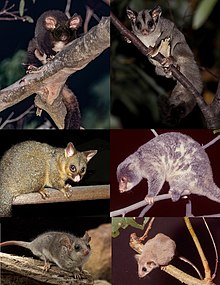
Phalangeriformes is a suborder of Australian marsupial mammals. Members of this suborder are called phalangeriformes, and include possums, gliders, and cuscus. Phalangeriformes is one of three suborders that form the order Diprotodontia, the largest extant order of marsupials. They are found in Australia, New Guinea, and Indonesia, generally in forests, though some species can also be found in shrublands and grasslands. They range in size from the Tasmanian pygmy possum, at 5 cm (2 in) plus a 6 cm (2 in) tail, to the cuscus of the genus Spilocuscus, at 64 cm (25 in) plus a 59 cm (23 in) tail. Phalangeriformes primarily eat leaves, fruit, and insects, though many are omnivorous and will eat small vertebrates or other plant material.
Many phalangeriformes do not have population estimates, but the ones that do range from 50 mature individuals to 75,000. No species have gone extinct in modern times, but four are categorized as endangered: Tate's triok, mahogany glider, Gebe cuscus, and Woodlark cuscus. A further eight species are categorized as critically endangered: Leadbeater's possum, northern glider, western ringtail possum, mountain pygmy possum, Talaud bear cuscus, Telefomin cuscus, black-spotted cuscus, and blue-eyed spotted cuscus.
The sixty-four extant species of Phalangeriformes are divided into six families grouped into two superfamilies: Petauroidea, containing two species in two genera in the family Acrobatidae, eleven in three genera in the family Petauridae, eighteen in six genera in the family Pseudocheiridae, and a single species in the family Tarsipedidae; and Phalangeroidea, containing five species in two genera in the family Burramyidae and twenty-seven in five genera in the family Phalangeridae. Several extinct Phalangeriformes species have been discovered, though due to ongoing research and discoveries the exact number and categorization is not fixed.[1]